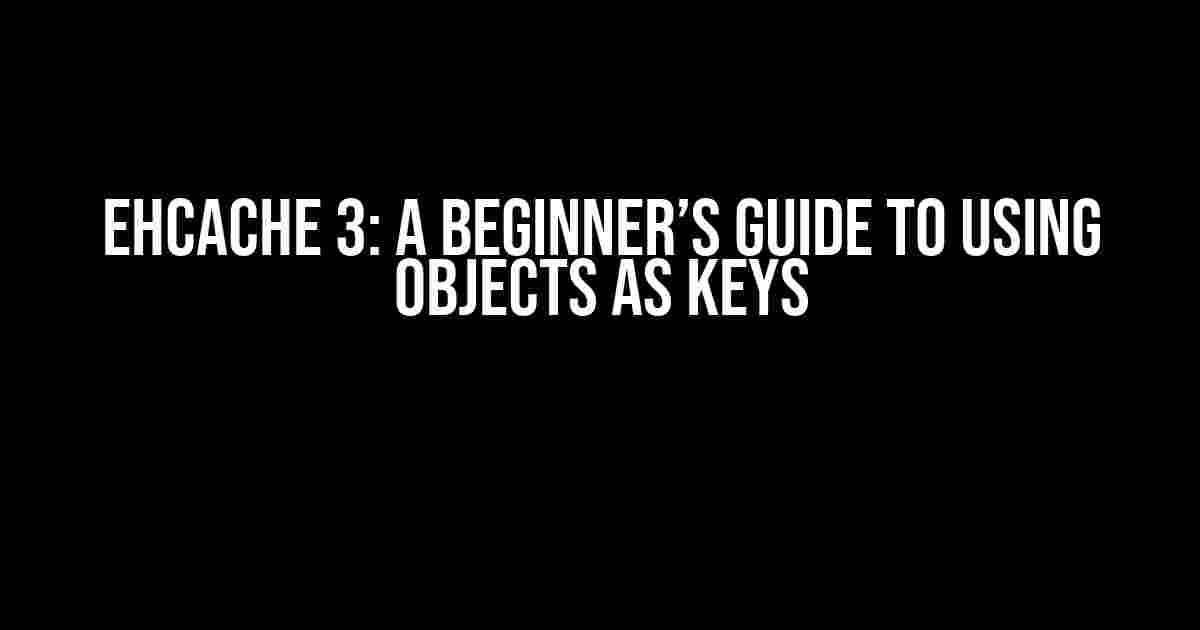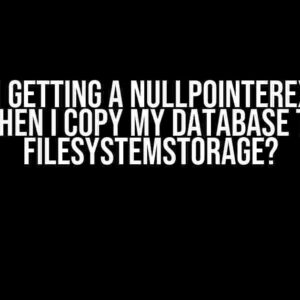Are you tired of using primitive data types as keys in your caching mechanism? Do you want to take your caching game to the next level by using objects as keys in EhCache 3? Look no further! In this comprehensive guide, we’ll take you on a journey to master the art of using objects as keys in EhCache 3.
Why Use Objects as Keys?
In traditional caching mechanisms, primitive data types such as strings, integers, or longs are used as keys. However, in complex applications, this approach can be limiting. By using objects as keys, you can:
- Cache complex data structures, such as custom objects or collections
- Improve cache hit ratio by using a more granular key structure
- Enhance data retrieval and storage efficiency
Understanding EhCache 3
EhCache 3 is a widely-used, open-source caching framework that provides a robust and scalable caching solution for Java-based applications. It supports various caching topologies, including in-memory, disk-based, and distributed caching.
To use objects as keys in EhCache 3, you need to understand the following concepts:
Cache: The core caching component that stores and retrieves data.CacheConfiguration: The configuration class that defines the cache setup.CacheKey: The interface that represents a cache key.
Preparing Your Object for Use as a Key
To use an object as a key in EhCache 3, you need to ensure that the object implements the Serializable interface and provides a suitable equals() and hashCode() implementation. This is because EhCache 3 relies on these methods to compare and hash the cache keys.
public class MyObject implements Serializable {
private String id;
private String name;
@Override
public boolean equals(Object obj) {
if (this == obj) {
return true;
}
if (!(obj instanceof MyObject)) {
return false;
}
MyObject other = (MyObject) obj;
return Objects.equals(id, other.id) && Objects.equals(name, other.name);
}
@Override
public int hashCode() {
return Objects.hash(id, name);
}
}
Configuring EhCache 3 to Use Objects as Keys
To configure EhCache 3 to use objects as keys, you need to create a custom CacheKey implementation and specify it in the CacheConfiguration.
public class MyObjectCacheKey implements CacheKey {
private MyObject object;
public MyObjectCacheKey(MyObject object) {
this.object = object;
}
@Override
public Object unwrap() {
return object;
}
@Override
public boolean equals(Object obj) {
if (this == obj) {
return true;
}
if (!(obj instanceof MyObjectCacheKey)) {
return false;
}
MyObjectCacheKey other = (MyObjectCacheKey) obj;
return object.equals(other.object);
}
@Override
public int hashCode() {
return object.hashCode();
}
}
In your CacheConfiguration, specify the custom CacheKey implementation:
CacheConfiguration cacheConfig = new CacheConfigurationBuilder()
.withCacheName("myCache")
.withSerializer(new JavaSerializer())
.withCacheKey(new MyObjectCacheKey())
.build();
Using Objects as Keys in EhCache 3
Now that you’ve configured EhCache 3 to use objects as keys, you can use your custom object as a key in your caching operations:
Cache cache = new Cache(cacheConfig);
MyObject myObject = new MyObject("id-1", "name-1");
cache.put(myObject, "value-1");
String value = cache.get(myObject);
System.out.println(value); // prints "value-1"
Best Practices and Considerations
When using objects as keys in EhCache 3, keep the following best practices and considerations in mind:
- Immutability**: Ensure that your object is immutable to prevent unintended changes to the cache key.
- Equals and HashCode**: Ensure that your object’s
equals()andhashCode()implementation are correct and consistent. - Serialization**: Ensure that your object is serializable and can be correctly deserialized.
- Cache Configuration**: Ensure that your cache configuration is correct and optimized for your use case.
Common Issues and Troubleshooting
When using objects as keys in EhCache 3, you may encounter the following common issues:
| Issue | Solution |
|---|---|
ClassNotFoundException during deserialization |
Ensure that the classloader has access to the serialized object’s class. |
Incorrect cache hits due to poor equals() and hashCode() implementation |
Review and correct your object’s equals() and hashCode() implementation. |
| Cache configuration issues resulting in poor performance | Review and optimize your cache configuration for your use case. |
Conclusion
In this comprehensive guide, we’ve demonstrated how to use objects as keys in EhCache 3. By understanding EhCache 3’s architecture, preparing your object for use as a key, configuring EhCache 3, and following best practices and considerations, you can unlock the full potential of object-based caching in your Java-based applications.
Remember to keep your objects immutable, ensure correct equals() and hashCode() implementation, and optimize your cache configuration for your use case. By doing so, you’ll be able to build faster, more scalable, and more efficient caching mechanisms that take your application to the next level.
Happy caching!
Frequently Asked Question
EhCache 3 is a powerful caching framework, but have you ever wondered how to use objects as keys? Well, wonder no more! Here are the top 5 FAQs about using objects as keys in EhCache 3.
Q1: Why do I need to use objects as keys in EhCache 3?
You need to use objects as keys in EhCache 3 when you want to cache data that is associated with a specific object, such as a user or a product. This allows you to efficiently retrieve and store data for that object.
Q2: What are the requirements for using objects as keys in EhCache 3?
To use objects as keys in EhCache 3, you need to implement the `serializable` interface and provide a proper `hashCode()` and `equals()` method implementation for your object.
Q3: How do I configure EhCache 3 to use objects as keys?
You can configure EhCache 3 to use objects as keys by specifying the `keyType` attribute in your cache configuration file, typically `ehcache.xml`. For example, `
Q4: How does EhCache 3 handle object equality when using objects as keys?
EhCache 3 uses the `equals()` method to determine object equality when using objects as keys. This means that you need to ensure that your object’s `equals()` method is properly implemented to identify duplicate objects.
Q5: What are some best practices for using objects as keys in EhCache 3?
Some best practices for using objects as keys in EhCache 3 include using immutable objects, avoiding using objects with high mutation rates, and ensuring that your objects have a proper `hashCode()` method implementation.


